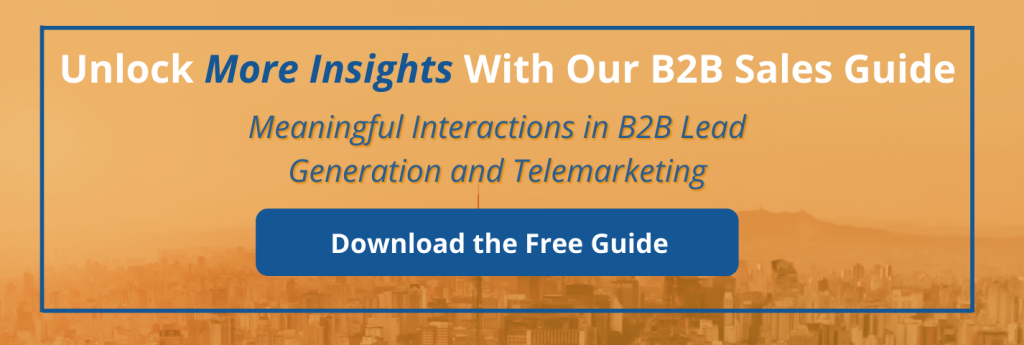Lead follow-up is a crucial step in the sales process.
A qualified lead can be wasted (and practically handed right over to the competition) if it is left to linger on the vine.
Inbound and outbound leads are generated differently, so the rules for follow-up will vary slightly. The basic principles are the same, but there are nuances for each that should be recognized.
It is not luck that increases your inside sales rate, but the consistent use of a proven formula that will lead to a close.
I have over 35 years of experience and success in complex sales and B2B lead generation. The following are what I consider to be the golden rules for handling lead follow-up:
1. Distribute Leads Wisely
This may seem like an obvious rule, but it is extremely important, and should not be overlooked. When you receive an inbound lead, someone has shown an interest in your company or your product. Even though it may be a marketing qualified lead, (MQL) it requires diligent follow-up and further qualification to turn in into a sales qualified lead (SQL).
Make sure you hand that interest to a business development representative who will act on it.
In every team, there are individuals who are motivated to make contact and put in the effort needed. A motivated person will take the steps needed to nurture the lead and give it the best opportunity to result in a sale. Make sure your lead is given to a rep who will follow through (if you don’t know who that is, now is the time to get to know your sales team).
It is also important that your sales representative pays attention to and acts on the information given about the sales lead in a timely manner. This can include sending follow-up emails, scheduling conference calls, and/or sending meeting invitations.
We recommend this first follow-up step take place within 24 hours of the outside rep receiving the qualified lead opportunity.
It is important to know your sales team and their strengths. Maybe you have someone with more knowledge of a particular industry or a history with a similar company. Don’t overlook these details, they are what can make the difference, and lead to a more meaningful interaction and a successful close.
2. Don’t Wait
Follow up with a lead, inbound OR outbound, as soon as possible. If someone has contacted you through your website, or because of digital advertising or content you’ve shared, something they saw made them want to reach out to you.
Not following up quickly is like throwing the lead to someone else – this seems obvious, but can be very prevalent when it comes to Internet leads.
Following up within 24 hours is essential. Any longer, and a potential customer may think they don’t matter, or that your sales team isn’t organized enough to follow up on potential leads; neither of which will lead to a meaningful interaction and potential sale.
Make sure you have processes in place, so that when there is an inbound lead, a follow-up call, email, or appointment is made as soon as possible.
When the lead comes from outbound sales and teleprospecting, follow-up within 24 hours is still essential. A qualified teleprospector will have had a conversation with a key decision maker and the lead should be highly qualified and actionable.
This is not when you want to drop the ball.
Once a conversation is 2-3 days old, the contact will lose recognition. An email and/or calendar invitation should go out ASAP, and the sales rep should make sure the contact accepts the invitation (be sure to check to see if your email has been received, and your calendar invitation accepted).
Another rule to follow for outbound leads: use specifics. When a teleprospector is turning a lead over to a sales rep, they should provide as many details as possible, a thorough and detailed lead sheet can be a powerful tool. These salient points should be referred to in the follow-up email.
It will not only help the contact remember the conversation, but will remind him or her that this is not a cold call, and that their potential as a fit has already been realized.
Mention the specifics, but keep the message short and to the point. If you are including an attachment, limit it to one. If the lead is qualified properly, that should guide the literature that you send along.
3. Be Persistent, Not Annoying
With any lead, persistence is necessary. Everyone is busy, and they may not return your call or email the first time, regardless of their interest. It is important to remain committed to the lead and not give up if the few first attempts are not successful.
For inbound leads, 6-10 attempts to contact a person is considered the industry norm. However, this is when a qualified sales rep should use their best judgment.
Often, more than 10 attempts would be too much; not only is this annoying to the contact, but it can also damage your brand. Evaluate what sort of lead it is, think about why there may be a delay, and follow up appropriately.
With a qualified outbound lead, there is a need for more restraint. Again, a highly qualified lead will be with a key decision maker; someone relatively high within a company. This person is most likely very busy and may not have time to respond, even if they have made the decision that they want to be contacted and move forward.
If, after several attempts at contact, there is still no response, it is good practice to kick it back to the person who generated the lead. This allows the representative with the familiar voice back on the line to re-establish the connection and can often lead to success.
High Close Rates and Successful Sales Cycles
Every sale and every lead is unique and requires knowledge and experience to be handled expertly in order to lead to a close.
However, I have found that using these rules as a fundamental guideline will create a consistent and successful formula for high close rates and successful sales cycles.
Thanks for visiting our blog,
Jim
Editor’s note: Originally published in 2015, this blog has been edited and updated in November 2018.



